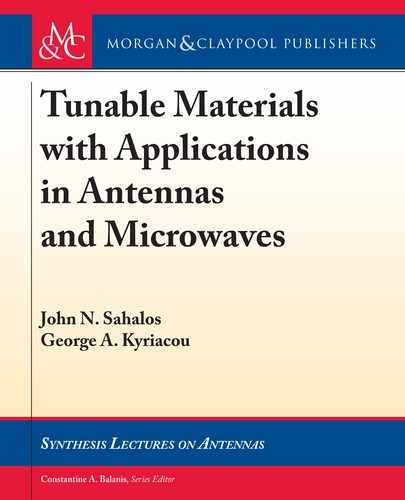
5.10. MULTILAYER COPLANAR WAVEGUIDE (CPW) 195
5.10 MULTILAYER COPLANAR WAVEGUIDE (CPW)
CPW technology is, in general, advantageous over microstrip in the convenience offered in the
shunt connection of microwave components, in addition to the series connection supported by
both. is is particularly important for microwave-integrated components. at is because it
avoids the necessity of backplane processing, which is inevitable in microstrip technology shunt
connections realized through electroplated ground plane via holes. However, CPW is inferior
against microstrip in efficient interconnections and components modeling due to the involved
complexity in its analytical electromagnetic analysis.
5.10.1 QUASI–STATIC APPROXIMATION
An asymmetric coplanar line printed in a multilayer structure is presented in Figure 5.6a. e
signal strip width is s and is separated by different gaps w
1
; w
2
from the left and the right
ground-strip conductors. ese strips are located between M C 1 dielectric layers from below
and N C 1 layers from above. Svacina [12] performed a conformal Christoffel–Schwartz trans-
formation, mapping this structure to the approximate equivalent formation of Figure 5.6b. e
coordinates in the transformed w-plane can be expressed in terms of the complete elliptic inte-
grals of the first kind K.k/ and K
0
.k/ D K.k
0
/ as [25]:
w D u Cj D K.k/ C jK
0
.k/ D K.k/ C jK.k
0
/; (5.28a)
where k
0
D
p
1 k
2
and the properties of elliptic integrals are elaborated in detail in standard
mathematical handbooks, e.g., [25].
Concerning the two ground strips of Figure 5.6a, these are mapped on the segments at D
˙
0
, while the signal conductor is mapped at D 0. Likewise, the layers i D 1 to M and j D 1
to N are mapped to a pair of symmetric strips, while the semi-infinite (usually air "
r
D
r
D 1)
layers i D M C 1 and j D N C 1 are mapped to two centrally located areas. e dimensions of
each ith-mapped layer is approximated as 2
0
.u
1
u
i1
/, where these coordinates are defined
by Eq. (5.28a) and their ratios are:
0
u
0
D 2
K.k
0
/
K.k/
;
0
u
i
D 2
K.k
0
i
/
K.k
i
/
(5.29a)

196 5. PLANAR TRANSMISSION LINES
(a)
w
1
s
h
j
h
N
u
1N
ε
+
u
N
ε
w
2
u
1
ε
ℓ
1M
ε
+
ℓ
M
ε
ℓ
i
ε
u
j
ε
ℓ
1
ε
ℓ
2
ε
h
M
h
i
h
1
h
2
(b)
υ
0
1 ×× j ××
N N+1 N ×× j ×× 1
1 2 ×× i ××M M+1 M ×× i ×× 2 1
u
1
u
2
u
i
u
M
u
0
-u
0
-υ
0
Figure 5.6: A multilayer asymmetric coplanar waveguide: (a) original z D x C jy plane and
(b) approximate conformal transform in w D u C j domain.

5.10. MULTILAYER COPLANAR WAVEGUIDE (CPW) 197
where
k
2
i
D 2
k
i1
C k
i2
.
1 C k
i1
/ .
1 C k
i2
/
(5.29b)
k
i1
D
sinh
4
s
h
i
sinh
4h
i
.s C 2w
1
/
(5.29c)
k
i2
D
sinh
4
s
h
i
sinh
4h
i
.
s C 2w
2
/
(5.29d)
and k
0
D 0, while for the semi-infinite top and bottom layers:
k D k
M C1
D k
N C1
D lim k
i
h
i
Dh
M C1
Dh
N C1
!0
D
s
.
s C w
1
C w
2
/
.
s C w
1
/ .
s C w
2
/
: (5.29e)
e latter is obtained by applying De L’Hospital’s rule on Eqs.(5.29c) and (5.29d) to yield
k
01
D
s
s C 2w
1
and k
02
D
s
s C 2w
2
: (5.29f)
In view of the above, the filing factor .q
i
/ for each ith layer is defined by the ratio of its
assigned area to the total cross-section .2u
0
2
0
D 4u
0
0
/, which using (5.29a) reads:
q
i
D
2
0
.u
i
u
i1
/
4u
0
0
D
1
2
0
u
0
u
i
0
u
i1
0
or (5.30a)
q
i
D
1
2
K.k
0
/
K.k/
K.k
i
/
K.k
0
i
/
K.k
i1
/
K.k
0
i1
/
: (5.30b)
Equation (5.30b) applies for both i D 1 to M C 1 and i ! j D 1 to N C 1 layers and
k
0
D 0.
e effective dielectric constant (quasi-static expression) results from a summation of the
product (q
i
"
ri
) over all layers as:
"
reff
D
M
C
1
X
iD1
q
i
e
l
ri
C
N
C
1
X
j D1
q
j
e
u
rj
(5.31)
l D lower; u D upper:
e above expressions can be significantly simplified in the symmetric CPW case, which
is worth a separate section.
..................Content has been hidden....................
You can't read the all page of ebook, please click here login for view all page.
